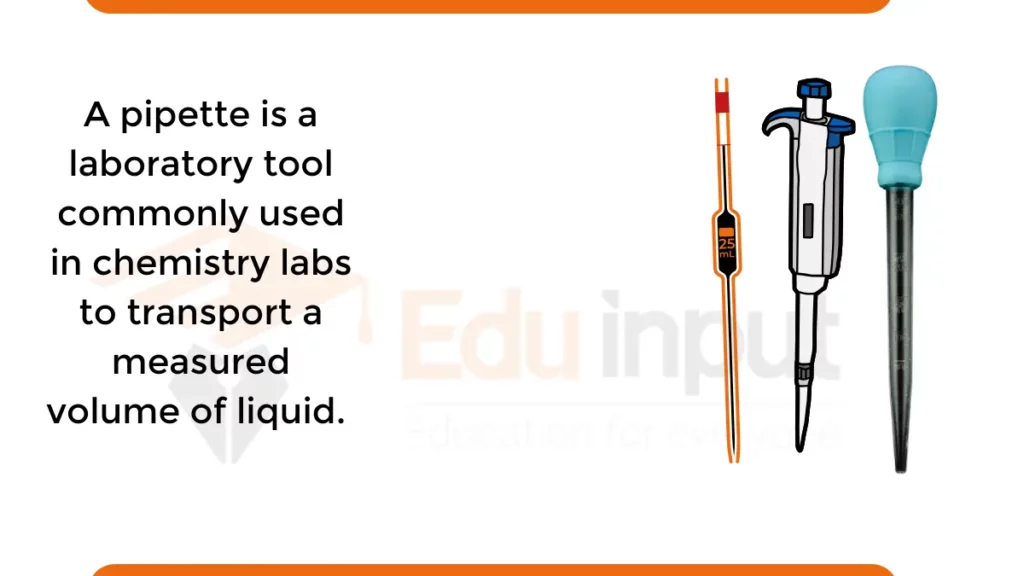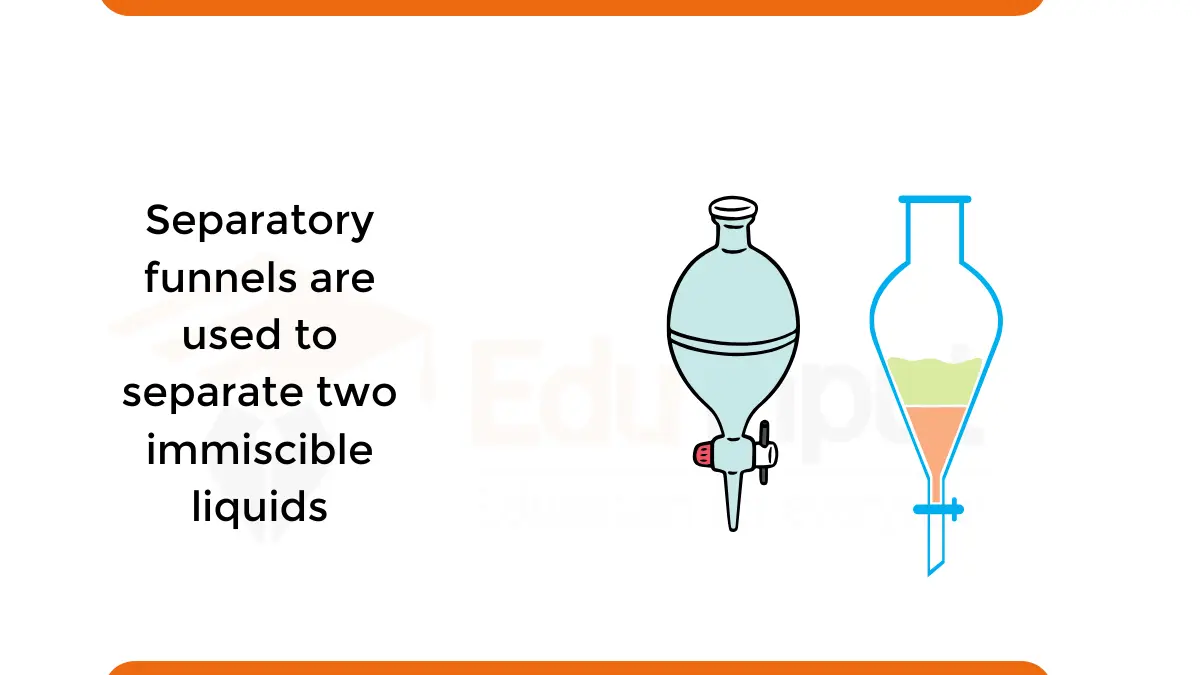Pipette-Principle, Types, and Uses
A pipette is a laboratory tool commonly used in chemistry labs to transport a measured volume of liquid.

Principle
Pipettes operate on principle of air displacement. When the plunger or bulb of the pipette is pressed, air inside the pipette is displaced. This displaced air creates a vacuum inside the pipette tip, which draws up liquid into the tip.
The volume of liquid drawn into the pipette depends on the volume of air that is displaced out of the pipette. For example, if 10 mL of air is pushed out of the pipette, 10 mL of liquid will be drawn into the tip to take its place.
With serological pipettes and volumetric pipettes, the pipette is designed and calibrated to displace a specific volume of air with each pump of the bulb. This in turn draws up an exact volume of liquid.
For adjustable pipettes like graduated pipettes and micropipettes, the position of the plunger determines the air volume displaced, allowing variable volumes to be drawn up. The graduations on adjustable pipettes indicate the different volumes they can deliver.
Releasing the bulb or plunger allows air back into the pipette, pushing the liquid back out of the tip at the bottom. In this way, a precise volume of liquid can be transported from one container to another.
The air displacement principle allows pipettes to reliably measure, transfer, and dispense exact liquid volumes by creating a vacuum – making them indispensable tools in chemistry laboratories.
Types
Here are main types of pipettes, and how they work:
1. Serological Pipettes
Serological pipettes are large pipettes used to measure and transfer volumes of liquid in the 1 to 100 mL range. They typically have graduations on the side to indicate the volume being transferred. Serological pipettes are often used for transferring large volumes of cells, media, or buffers in biology and microbiology labs.
How to use a serological pipette:
- Attach a disposable pipette tip to the serological pipette.
- Use a pipette filler to draw liquid into the pipette tip.
- Carefully dispense the liquid into the desired container.
- Remove the pipette tip and dispose of it properly.
2. Volumetric Pipettes
Volumetric pipettes, also known as Mohr pipettes, are designed to very accurately measure and transfer a specific volume of liquid, usually in the 1 to 100 mL range. There is a bulb at the top to draw liquid into the tube, which has a single graduation mark indicating the volume it contains. Volumetric pipettes are used to prepare solutions of known concentration and for other precise liquid measurements.
How to use a volumetric pipette:
- Fill the volumetric pipette with liquid to the top of the bulb.
- Place a finger over the top of the pipette to prevent the liquid from leaking out.
- Carefully dispense the liquid into the desired container until the meniscus is exactly at the graduation mark.
- Touch the tip of the pipette against the side of the container to release any remaining liquid.
3. Graduated Pipettes
Graduated pipettes, also known as Finn pipettes, can measure and transfer variable volumes of liquid with precision. They have graduated markings along the length of the pipette showing different volume amounts. Graduated pipettes are used for a variety of tasks in the chemistry lab, such as measuring reagents, preparing solutions, and performing titrations.
How to use a graduated pipette:
- Use a pipette filler to draw liquid into the graduated pipette until the desired volume is reached.
- Carefully dispense the liquid into the desired container.
- Touch the tip of the pipette against the side of the container to release any remaining liquid.
4. Micropipettes
Micropipettes are used to accurately measure and transfer very small volumes of liquid, in the microliter or nanoliter range. The volume is set by a sliding mechanism on the micropipette. Disposable plastic tips are used with micropipettes to prevent contamination and ensure accuracy. Micropipettes are essential tools in molecular biology and other fields that require precise liquid measurements.
How to use a micropipette:
- Attach a disposable pipette tip to the micropipette.
- Set the volume on the micropipette to the desired volume.
- Use the plunger on the micropipette to draw liquid into the pipette tip.
- Carefully dispense the liquid into the desired container.
- Remove the pipette tip and dispose of it properly.
5. Pasteur Pipettes
Pasteur pipettes are simple pipettes made of glass used to transfer small quantities of liquids. They do not have volume markings. Pasteur pipettes are often used for transferring liquid between containers or for adding small amounts of liquid to reactions.
How to use a Pasteur pipette:
- Use a pipette bulb to draw liquid into the Pasteur pipette.
- Carefully dispense the liquid into the desired container.
- Clean the Pasteur pipette after use.
Uses of Pipettes
Here are some of the primary uses of pipettes:
- Measuring Liquid Volumes – Pipettes are widely employed for accurately measuring liquid volumes, ranging from small microliters to larger milliliters. They play a crucial role in preparing solutions of known concentrations, performing titrations, and conducting quantitative analyses.
- Transferring Liquids – Pipettes facilitate the safe and efficient transfer of liquids between containers. They are particularly useful when dealing with small volumes or hazardous substances, ensuring precise delivery and minimizing spills.
- Dispensing Reagents – Pipettes are essential for accurately dispensing reagents into reactions, ensuring that the correct amount of each component is added to achieve the desired outcome. They are particularly important in enzymatic assays, PCR reactions, and other sensitive procedures.
- Sample Preparation – Pipettes are commonly used in sample preparation for various analytical techniques. They ensure that precise aliquots of samples are transferred for analysis, enabling accurate and reproducible results.
- DNA and RNA Work – Pipettes are indispensable tools in molecular biology and genetic research. They are used to measure and transfer minute amounts of DNA and RNA for amplification, sequencing, and other molecular manipulations.
- Drug Delivery – Pipettes are employed in pharmaceutical research and clinical settings for precise drug delivery. They are used to prepare and administer controlled amounts of medications, ensuring accurate dosing and patient safety.
- Microscopy – Pipettes are crucial for preparing samples for microscopic examination. They allow for the precise delivery of small volumes of cells, suspensions, or reagents onto microscope slides, enabling detailed observation and analysis.







Leave a Reply